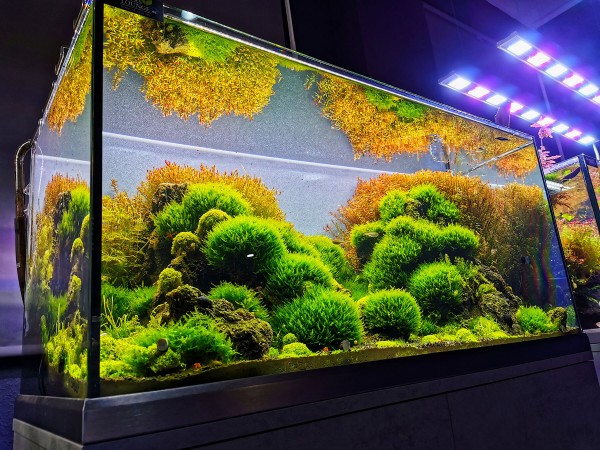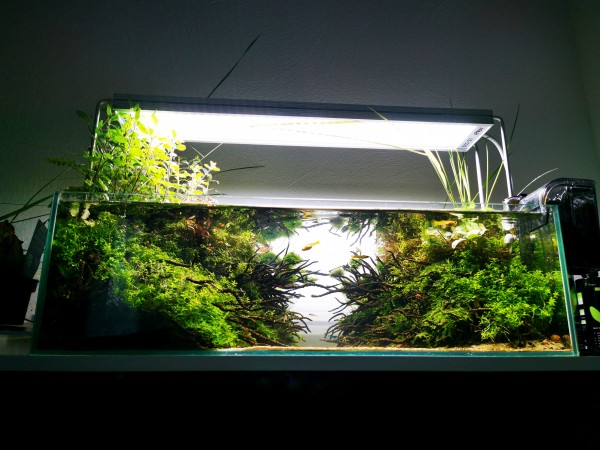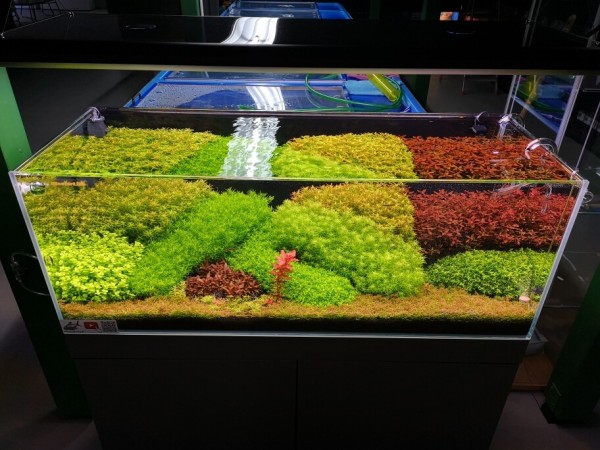LED lighting in aquaristics
The progress and innovation contrasting to common fluorescent tubes and HQI burners can not be denied, especially in the age of climate discussions. One more reason to look around in the LED jungle a little closer and to take by a change also still efficient consideration for the environment.
Table of contents

Not every LED for every aquarium
As varied as the types of aquariums maintained are, LED lights can vary and not necessarily every one harmonizes with every tank. Aquascaping in particular usually focuses on maximum light output with high lumens, as well as integrated RGB modules. However, the same lamp with more cold white tones might again be unsuitable for a rather shadier maintained blackwater aquarium. The light intensity in the aquarium depends, among other things, on the selection of fish, but also the aquatic plants. Some fish species panic if the aquarium is too brightly lit. An LED that can be dimmed gradually, on the other hand, might be more suitable. Those who value a biotope aquarium that is as harmonious as possible are best advised to use lamps that can simulate weather and entire seasons, as well as times of day with sunrise and sunset. Gentle dimming up and down of LEDs contributes to the well-being of sensitive fish in particular, because they are not familiar with sudden light conditions from nature, so that abruptly switching on the aquarium lighting may well cause skittish comrades to jump out of the aquarium or rush through the tank in panic and possibly injure themselves.

Conversion of the light requirement from watts to lumens
Whereas in the past the light requirement of aquarium plants was calculated using the so-called watt-per-liter rule, with LEDs this is now based on lumens (lm) per liter. While a low light requirement corresponded to about 0.2-0.3 watts per liter with conventional fluorescent tubes, this translates to 15-20 lumens per liter with LEDs, suitable for Bucephalandra, Anubia, Javafarn or even Cryptocorynen. A medium light requirement of 0.5 W/l is therefore equivalent to 30 lm/l such as for ground cover and stem plants, and a high light requirement of 1 W/l to 60 lm/l. This is mainly needed for orange and red-leaved aquatic plants.
Real efficiency in aquarium lighting can be achieved in terms of power consumption when a low current draw produces a high luminous fl ux. Dividing these two units, lumens by watts (lm/W) defines the luminous efficacy. Thus, if there is a high value of lumens per watt, this corresponds to an efficient and therefore power-saving LED.
Although aquarium LEDs appear cost-intensive at first glance, they have rightly become standard in most complete sets. However, if you consider the annual replacement of T5 or T8 tubes with their overall higher energy consumption against LED modules, the amortization in the wallet but already shows very quickly. As an example, a standard 54 liter aquarium is usually illuminated with 2x T5, each consuming 24 watts. This is based on 0.9 watts per liter, which corresponds to 60 lm/l. Converted from the tubes to an LED, it turns out that the energy consumption could well be moved from the former 48 watts to about 20 watts, which is less than half of that.
The main statement that aquaristics is not a sustainable hobby because of the energy consumption can be easily disproved thanks to innovative LED technology. At least annually, if not every 9 months, fluorescent tubes should be replaced, which in turn hit the wallet, not to mention the enormous use of resources as well as the recycling effort. Moreover, weak tubes usually lead to algae problems if they are not replaced or are replaced too late. LED luminaires have an average operating life of 50,000 hours. Converted to a daily average illumination time of 8-10 hours, the advantage is obvious. But even with LEDs, it is important to focus on efficiency and to determine the primary need. High light requirements are preferably met with high lumens-per-liter (lm/l). Low-energy LEDs are primarily pure white without additional RGB modules. These offer less efficiency than more color accentuation of plants and fish.

Progress is unstoppable
In the meantime, however, LED technology has also been tinkered with and researched, so that some manufacturers now offer high-performance LEDs that have primarily screwed on the photosynthetically active radiation range, also called PAR (Photosynthetic Active Radiation), and offer full-spectrum LEDs that combine several components. As we now know from aquaristics, some animals can be bred or cared for better, especially under daylight. So we can expect with excitement innovations in the field of lighting, which will offer an authentic sunlight spectrum under consideration of the UV factors and go beyond the aquaristics.
